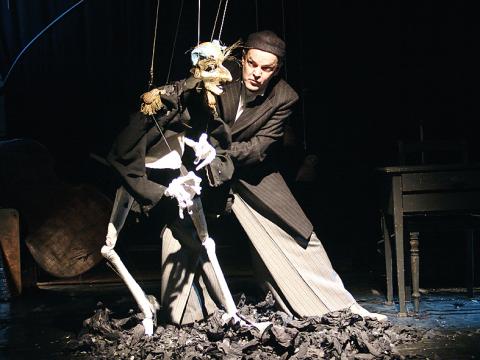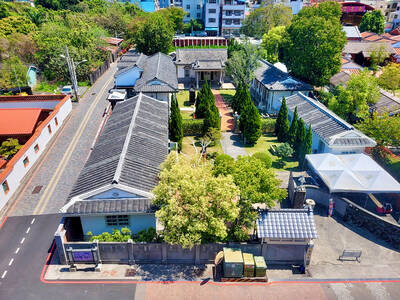For its debut performance in Taiwan, German puppet group Figuren Theater Tubingen will perform Salto.Lamento, or the “nocturnal side of affairs.”
The award-winning production was inspired by the medieval iconography of the Dance of Death, a funeral rite practiced when Europe lost much of its population to the Black Death during the 14th century.
Acclaimed German puppeteer Frank Soehnle, who cofounded the group with Karin Ersching in 1991, says that puppetry is a good vehicle for presenting skeletons dancing with people, which also reminds him of the relationship between himself and his puppet.

Photo Courtesy of Figuren Theater Tubingen
“In puppetry, you don’t look only at the puppets. You also look at the puppeteer and what is happening in this [puppeteer-puppet] relationship. It’s like a dance. It’s like giving life or taking death from one to the other,” Soehnle told the Taipei Times.
Without one uttered word, the piece is an exquisite danse macabre between the sole puppeteer and his array of puppets. They depict various characters, from a flirtatious half-woman, half-horse puppet to a monastic figure and a naughty sheep-goat creation. The performance is composed of vignettes choreographed to live music by Johannes Frisch and Stefan Mertin, who have been working with Soehnle since their first collaboration 20 years ago.
Like an alchemist, Soehnle instills life into the inert figures with a superb artistry. He exerts a light twist of the strings or a slight maneuver of a stick and the puppets swing into action as if they were completely autonomous. The interplay between life and death finds its most intense manifestation when a life-size masked faun manages to sever its strings and gain freedom. But the creature soon suffers the consequences of its actions and falls lifeless to the floor.
Inhabited by skeletal figures and chimeric creatures, the world of Salto.Lamento is as nightmarish and somber as it is playful and comical. Some puppets display a zany sense of humor, like a fussy devilish figure that demands live accompaniment from the musician duo when he sweeps and cleans.
Frisch and Mertin, who play live on stage, interact and communicate with the puppets with their instruments.
“The music is never the same,” the 48-year-old puppeteer said. “It is breathing with the whole performance.”
After five sold-out performances in Taipei last week, the group moves on to Tainan tomorrow.

April 28 to May 4 During the Japanese colonial era, a city’s “first” high school typically served Japanese students, while Taiwanese attended the “second” high school. Only in Taichung was this reversed. That’s because when Taichung First High School opened its doors on May 1, 1915 to serve Taiwanese students who were previously barred from secondary education, it was the only high school in town. Former principal Hideo Azukisawa threatened to quit when the government in 1922 attempted to transfer the “first” designation to a new local high school for Japanese students, leading to this unusual situation. Prior to the Taichung First

Chinese Nationalist Party (KMT) Chairman Eric Chu (朱立倫) hatched a bold plan to charge forward and seize the initiative when he held a protest in front of the Taipei City Prosecutors’ Office. Though risky, because illegal, its success would help tackle at least six problems facing both himself and the KMT. What he did not see coming was Taipei Mayor Chiang Wan-an (將萬安) tripping him up out of the gate. In spite of Chu being the most consequential and successful KMT chairman since the early 2010s — arguably saving the party from financial ruin and restoring its electoral viability —

The Ministry of Education last month proposed a nationwide ban on mobile devices in schools, aiming to curb concerns over student phone addiction. Under the revised regulation, which will take effect in August, teachers and schools will be required to collect mobile devices — including phones, laptops and wearables devices — for safekeeping during school hours, unless they are being used for educational purposes. For Chang Fong-ching (張鳳琴), the ban will have a positive impact. “It’s a good move,” says the professor in the department of

Toward the outside edge of Taichung City, in Wufeng District (霧峰去), sits a sprawling collection of single-story buildings with tiled roofs belonging to the Wufeng Lin (霧峰林家) family, who rose to prominence through success in military, commercial, and artistic endeavors in the 19th century. Most of these buildings have brick walls and tiled roofs in the traditional reddish-brown color, but in the middle is one incongruous property with bright white walls and a black tiled roof: Yipu Garden (頤圃). Purists may scoff at the Japanese-style exterior and its radical departure from the Fujianese architectural style of the surrounding buildings. However, the property